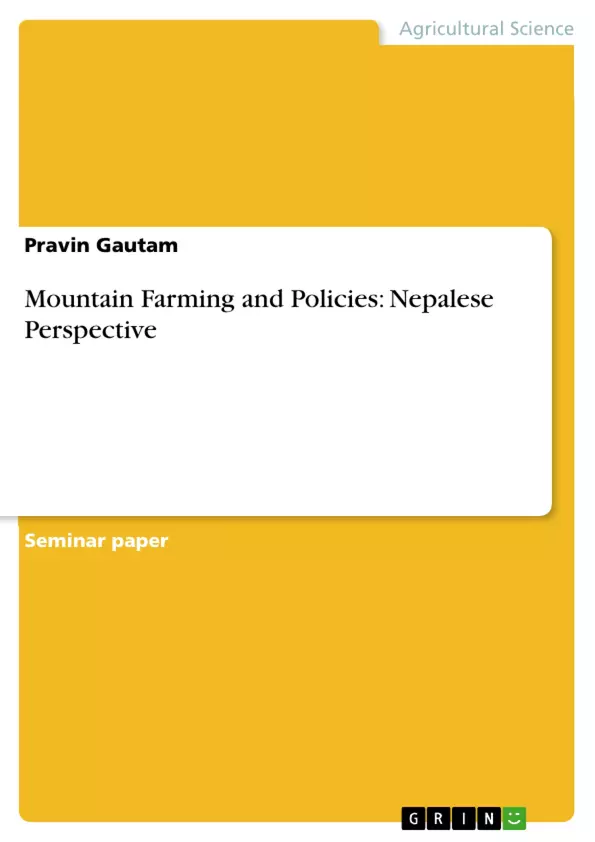Geographical Condition: Nepal, predominantly a mountainous, agrarian and landlocked country, has an area of 147,181 sq.km. with a population of about 22.3 million. It is geographically divided into three geo-ecological zones: Mountain (4,877m – 8,848 m above the mean sea level), Hills (610 m – 4,877m), and Terai (59 m – 610m).
The Terai region, a low flat land, is an extension of the Gangetic plains of India. It is a narrow tropical belt occupying 23 percent of the country’s total land area providing dwelling to 49.06 percent of the total population. About 40 percent area of the region is cultivable. [...]
Inhaltsverzeichnis (Table of Contents)
- Geographical Condition
- Socio-economic Life in the Nepalese Mountains
- Biodiversity
- Social Indicators
- Agricultural Aspect
- Food Crops
- Livestock
- Policy Regime
- Evaluation of Past Policies
- Mountain Development Issues in Policies
Zielsetzung und Themenschwerpunkte (Objectives and Key Themes)
This document aims to provide a comprehensive analysis of mountain farming practices and policies in Nepal, highlighting the socio-economic challenges faced by mountain farmers and exploring potential solutions. It aims to offer a nuanced understanding of the interconnectedness of environmental, social, and economic factors impacting mountain agriculture.
- Challenges faced by mountain farmers in Nepal
- Impact of poverty and disparities on mountain communities
- The importance of biodiversity and its underutilization for mountain development
- Evaluation of past agricultural policies and their impact on mountain farming
- Opportunities for sustainable development in mountain regions
Zusammenfassung der Kapitel (Chapter Summaries)
- Geographical Condition: This chapter provides an overview of Nepal's geographical features, highlighting the unique challenges faced by mountain farmers due to the country's rugged terrain, limited cultivable land, and varying climatic conditions.
- Socio-economic Life in the Nepalese Mountains: This chapter delves into the socio-economic realities of mountain communities in Nepal, emphasizing the high poverty rates, limited access to social services, and the challenges they face in achieving sustainable livelihoods. The importance of biodiversity and its underutilization for mountain development are also highlighted.
- Agricultural Aspect: This chapter focuses on the agricultural practices of mountain farmers, emphasizing the importance of livestock, the challenges of land fragmentation and limited irrigation facilities, and the impact of climate change on agricultural production.
- Policy Regime: This chapter analyzes the evolution of agricultural policies in Nepal, examining the objectives, strategies, and limitations of past development plans and their impact on mountain farming practices.
Schlüsselwörter (Keywords)
Mountain farming, Nepal, poverty, biodiversity, agricultural policies, development, socio-economic challenges, sustainable livelihoods, land fragmentation, irrigation, livestock, climate change, food security.
- Citation du texte
- Pravin Gautam (Auteur), 2002, Mountain Farming and Policies: Nepalese Perspective , Munich, GRIN Verlag, https://www.grin.com/document/177250



